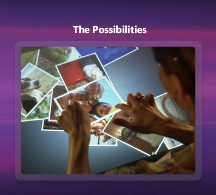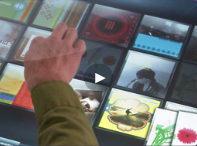
Microsoft Surface© interface
Some ideas about issues of interface, and the storytelling around the making of a film project, utilizing the nascent Microsoft surface© technology.

the sharing, image-shifting capacity
of the surface© technology.
Films (motion picture and television applications) are based on a sequence of actions:
- A story.
- A team that’s built to produce the film — could be investors, production team, director, studio management.
- A team that works on the story development — screen writer, director, staff.
- Another team that begins to build out the imagery of the style of the film.
The film’s director usually partners with a production designer, set designer, art director and a storyboard artist.
I was thinking about my experience working in film, on various teams, when the beginnings of the production are being set, exploring and styling the film. In working on The Matrix, Beowulf, or Spiderwick; Unforgiven, A Series of Unfortunate Events, or Star Trek…the nature of production design is about how the story will look.
Management of imagery and the culling of stylistic content is paramount. Having lots of content to access is key – lots of visuals, textual content, all that.
Some directors, like JJAbrams (Lost, Alias, M:i:III / Cloverfield), tend to operate on the presumptions of extensively planned styling. And storyboarding. The entire production is mapped out. Artists are hired to literally story-board the ideas and shooting sequences. So in meeting with the set production design team for Star Trek, as an example — under the highest scrutiny and secrecy, I might add, since this is part of a vast undercover branding effort — it’s important to absolutely control the assets, keeping secret the styling of the film. [Star Trek fans are notorious for knowing more — getting on set, stealing assets, references, anything to leak onto the pool of StarTrekian maniacs. Even reading the script is an onsite access only — nothing about the film leaves the lot].
What happens next in the process is about gathering and stylistically setting the entire visualizations for the complete production design. This often manifests into walls and walls of hundreds of images, sketches, notes — photographic references, digital “assemblage” — all stringed out in sequence for production planning. So, for example, one scene might actually be a grouping of text, notes, imagery, photographs and illustrations. From these collages, everything is designed.
When I work on a film, that’s what I’m looking for — what’s the look of it? How does it feel, holistically? There’s a great deal of more research for me and the staff, of course. But, doing the work, you’ve got to go to the collages and ideations on the film lot.
Same for Matrix.
All of the Mission: Impossibles;
Lemony Snicket,
Sahara,
Indiana Jones,
all the Star Treks.
Even Sky Captain.
Aeon Flux.
Transformers.
Iron Man…
Beowulf.
We take what we gather, and build it out — from script to stills, production design development, to visualized expressions of identity:
http://blog.girvin.com/?p=496
http://blog.girvin.com/?p=522
https://www.girvin.com/blog/direct-marketing-and-brand-identity/
http://www.beowulfmovie.com/
Now what I envisage for Microsoft’s surface© is a kind of roving – horizontal, sliding gathering scale that expands vertically and horizontally, to frame a vast grouping of production details — fluently and fluidly, accessed. Instantly accessible, yet rearrangeable. Instead of walls and walls — all in the containment of surface© technology:

All images from Microsoft Surface© interface.
This could be very, very cool.
What’s your take?
TSG | Lowell, Idaho